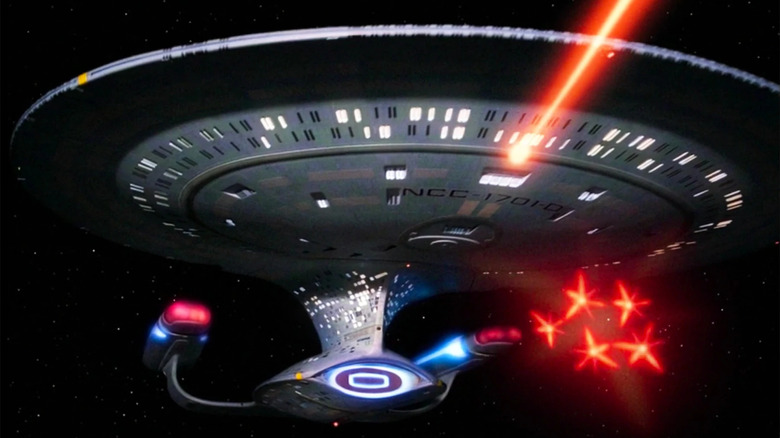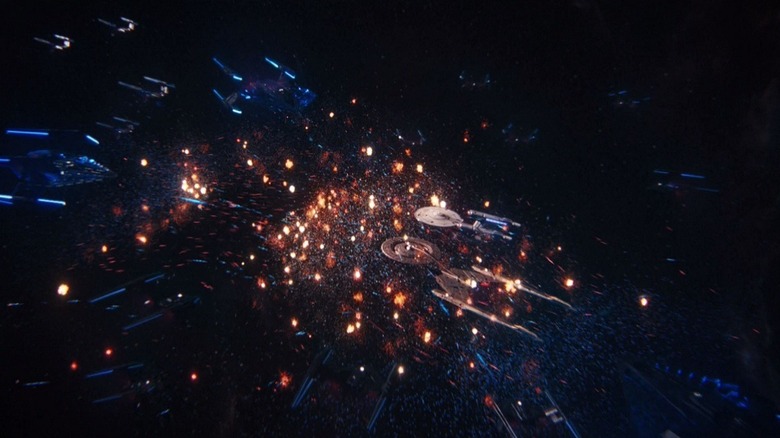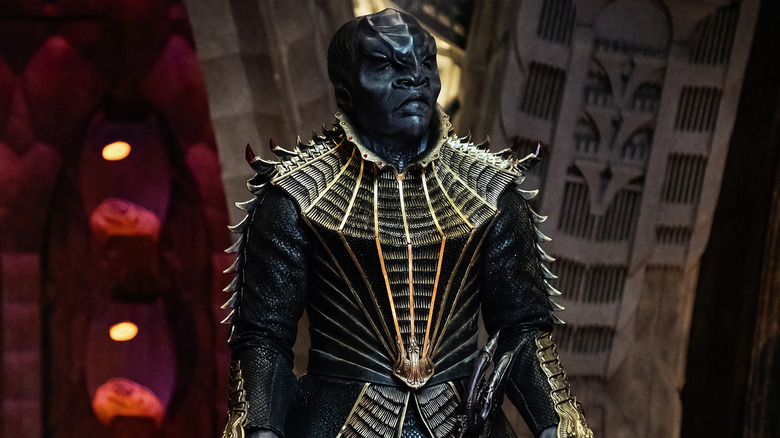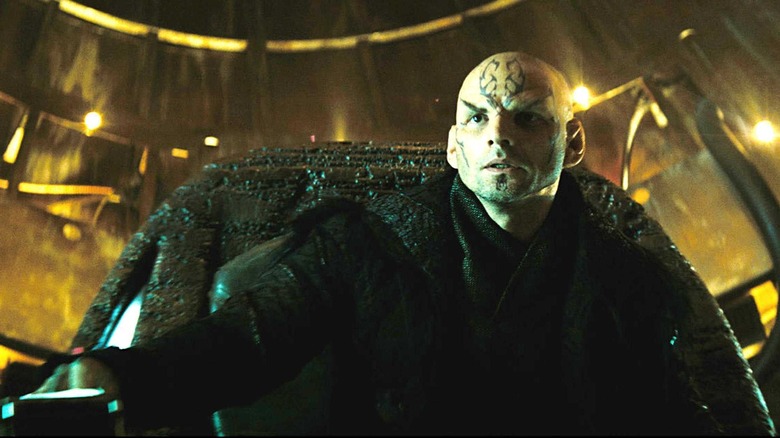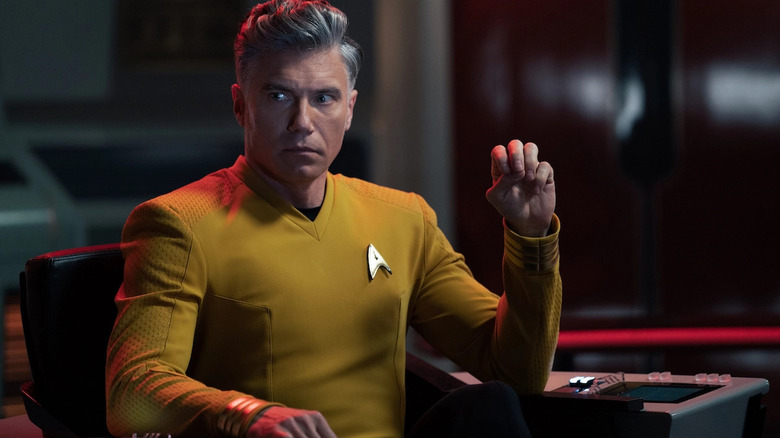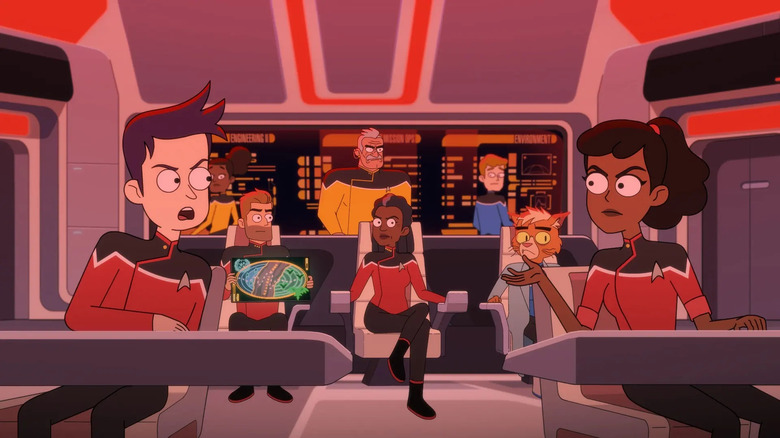Star Trek Wars: Why Star Trek's Pacifism Will Always Be So Important
This author has heard numerous peers and geek-forward pundits muse out loud who might defeat the other in a full-scale, weapons-forward space battle between the U.S.S. Enterprise-D from "Star Trek: The Next Generation" and an Imperial Star Destroyer from the "Star Wars" movies. The conversation prompt, designed to glorify in nitpicky details of both franchises, will inevitably entail tactical advantages like ship maneuverability, weapons complement, the attitude of the ships' respective captains, and the power of phasers vs. blasters. "Who would win in a fight?" remains, even at this late date, the central conundrum of most mainstream fantasy entertainment.
And while it may be fun to parse out the details of such a conflict, Trekkies may find themselves at odds with the question. Who would win in a fight, you ask? Perhaps the more important question is: why is the Enterprise fighting at all? Was there a breakdown of diplomatic talks? Did the Empire enter the Neutral Zone without authorization? Few alien worlds in "Star Trek," even the more aggressive ones, would fire on a Starfleet vessel unprovoked. Trekkies may immediately see the Star Destroyer attack as a diversionary tactic, meant to draw the Enterprise's attention while something even more sinister is going on behind them.
These fan-posited queries of a Star Destroyer's motivations, of course, are merely playful. Such questions, however, reveal something vital about "Star Trek" and the franchise's central thesis. Namely, "Star Trek" is a pacifist show. War, might, tactics, firepower, destruction. These are the purview of "Star Wars," a series devoted to ridding the galaxy of tyranny through violent means. Peace, diplomacy, multiculturalism, tolerance, exploration, and cultural sensitivity. These are vital building blocks of "Star Trek."
Kelvin, Discovery, and War
From 1987 all the way through 2005, new "Star Trek" shows were running constantly. "Star Trek: The Next Generation" ran for seven years, with "Star Trek: Deep Space Nine" overlapping with its final two seasons. It also lasted seven years. "Star Trek: Voyager" launched in 1995, and its ending — seven years later — led directly to the debut of "Star Trek: Enterprise" in 2001. That show ended after its fourth season. This was, for many, the heyday of "Star Trek." The franchise seemed to have found a groove and regularly turned out quality stories that continued to push forward Trek's pacifist ideal. When war did break out on "Deep Space Nine," it was seen as the ultimate failing. The Dominion War was not a fight against tyranny, but a dark last resort that no one in the Federation wanted. This was, DS9 constantly reiterated, not a good war. The goal was not triumph, but just its end.
Something changed in Trek since then.
To illustrate: The above picture is a still from an episode of "Star Trek: Discovery." The visual cluster**** sees the U.S.S. Discovery and the U.S.S. Enterprise in the middle of a weapons barrage from the surrounding starships. It looks like a fireworks display. Long gone, it seems, are the slow-moving, submarine-like tactics that audiences enjoyed at the climax of Nicholas Meyer's "Star Trek II: The Wrath of Khan." Thanks to advances in special effects technology, the screen can now be filled with fast-moving dogfighters that let loose with rapid-fire phaser blasts, multiple explosions, and endless death and violence. The first season of "Discovery" took place during the Klingon War prior to the original series.
It was more violent than ever.
What changed?
Lest one begin to assume that this article exists merely to cast shade on "Discovery" and vaunt the "old ways," let the reader be reassured that this article will not mention any of Disco's rushed, weak character work or shabby, rushed storytelling. Indeed, "Discovery" may be admired for its representation alone, featuring more queer characters than all of the previous Trek shows combined. In terms of diversity, "Discovery" is first-rate.
In terms of its devotion to pacifism, well ...
It's rare that an episode of "Discovery" will elapse without one of the central characters committing murder. Such murders are in a firefight context, but the firefights seem to occur with greater regularity than in previous years. There may be lip service paid to exploration, a love of science, belief in negotiation, but ... the spirit is off. A viewer might feel that the makers of "Discovery" want to make their characters "hard-edged," and have allowed them to deal death as an example. Few of the characters have stepped forward to stop an act of war.
Trek's propensity toward violence, of course, did not begin with "Discovery." The NextGen movies pushed the door open; beyond "Generations," those films were staged like action flicks.
The violence-and thrill-forward version of Trek came to a head in 2009 with the release of J.J. Abram's feature film. It's notable that both "Star Trek" and "Star Wars" closed in earnest in 2005 (the "Star Wars" animated output notwithstanding). In 2009, audiences were thirsty for both, and Abrams took some of the characters and iconography from Trek and told a story in the attitude of Wars. It was a drug for those who needed a Kirk fix, as well as a Han Solo one. It's no wonder it was a hit.
Kelvin's folly
The Kelvin timeline films, as the Abrams' movies are called, featured hotter, younger versions of the Trek characters we all know and love, giving the filmmakers an organic excuse to have them behave rashly, impulsively, and a little out of character. Abrams' "Star Trek" was the high-octane, "Star Wars"-inflected version of Trek. Following the mold of "The Wrath of Khan," it was also about a vengeance-minded supervillain — Nero (Eric Bana) — who sought to pick a fight. It had more shooting, running, yelling, and explosions than Trek ever did before. No one cared for quiet, thoughtful brainstorming sessions in conference rooms, à la Capt. Picard (Patrick Stewart).
The 2009 film took a landscape already sowed with the likes of "Star Trek: First Contact," and fundamentally altered Trek into a combat-forward franchise. A new generation had creatively taken the helm, and the new doctrine was violence-forward. Pacifism didn't sell. It's certainly telling that once "Star Wars" did come back in 2015 with "Star Wars: The Force Awakens," the following "Star Trek" movie — "Star Trek Beyond" — didn't do nearly as well at the box office.
But the damage was done. "Star Trek" stopped being about pacifism, thoughtfulness, exploration, and other slow, dull things that nerds love (nerds like me). For the better part of a decade, "Star Trek" wasn't about peace. It was about war. The central tenet of NextGen, with Picard negotiating treaties and shuttling diplomats to peace talks, was a thing of the past. When Paramount took Trek back to TV in 2017 and returned to the central known Trek timeline (the 2009 film took place in a parallel universe), the doctrine of combat was retained. The level of violence and death seen regularly on "Discovery" and "Star Trek: Picard" denoted a new era of war.
Or so it seemed.
Star Trek: Redemption
A recent episode of "Star Trek: Strange New Worlds" not only returned Trek to its original pacifist doctrine but did so in a thrilling way. In "A Quality of Mercy," the final episode of the first season, Capt. Pike (Anson Mount) found himself living out a potential future scenario. His consciousness is projected into an alternate timeline wherein he, and not Capt. Kirk, is in command of the U.S.S. Enterprise during the events of the original series episode "Balance of Terror." In that episode, Kirk faced off with an unseen Romulan vessel, and the two ships used intense, clever tactics to fire shots and do damage to one another. It's an excellent episode.
Pike, it so happens, is not the tactician that Kirk was, preferring light conversation and diplomacy above all else. Pike — the genial, friendly captain — saw the tense battle scenario as an opportunity to flex his diplomatic muscles, and didn't think to fire any shots. Pike's ploy would have worked, were it not for an unknown Romulan underling fouling things up for his commander, and were it not for Kirk (Paul Wesley) popping up with a show of strength.
Themes of fatalism aside, "A Quality of Mercy" was making the argument that all scenarios — even Trek's most famously battle-forward — could have been solved with a more pacifist philosophy in place. "Strange New Worlds" has brought the show around again. It's a show populated by gentle, intelligent characters who love their job, believe in Starfleet, and are keen to see the future remain a utopia.
A lasting peace
The return to peace is also marked by "Star Trek: Lower Decks." Although the show is an animated comedy, the characters are devoted — on a philosophical level — the ideals of Starfleet. The show's central joke comes from the fact that the U.S.S. Cerritos is one of the less popular, less important ships in the fleet. But even as each character struggles to retain dignity, they are still eager to help. "Lower Decks" points out that the currency of "Star Trek" is prestige. It's a race to see who can help the galaxy more. While crass, it's also open-minded and, dare I say, kind.
In in-universe chronological terms, perhaps the darkness of "Discovery" makes sense. Disco takes place prior to the original series and provides violence. A few years hence, the world is run by Kirk's submarine tactics. 80-some years beyond, we get NextGen's formalism. I guess by the year "Picard" takes place, Starfleet will have fallen apart again.
The future, as Gene Roddenberry saw it, would be a better time specifically because petty conflicts were behind us. In Trek lore, the Earth needed to survive a nuclear near-holocaust and make contact with visitors from beyond the stars before its citizens could finally put their differences aside. "Star Trek," then, was — by its very construction — specifically post-war. This is a universe with combat behind it.
As Jonathan Larson once said, the opposite of war is not peace, but creation. "Star Trek" is about humanity reaching a time when petty, violent squabbles and devotion to power and domination have given way to expansion, exploration, and intellectualism.
The war, it seems, might finally be at an end.
